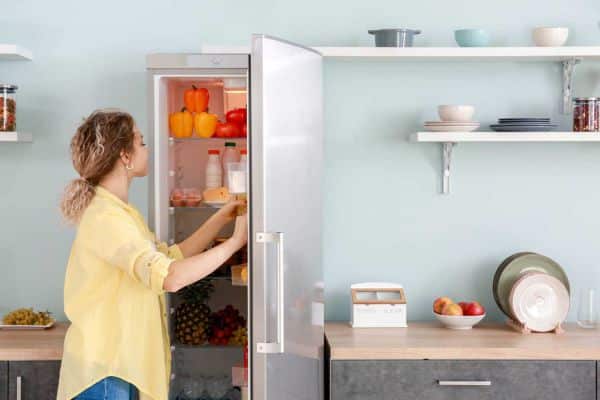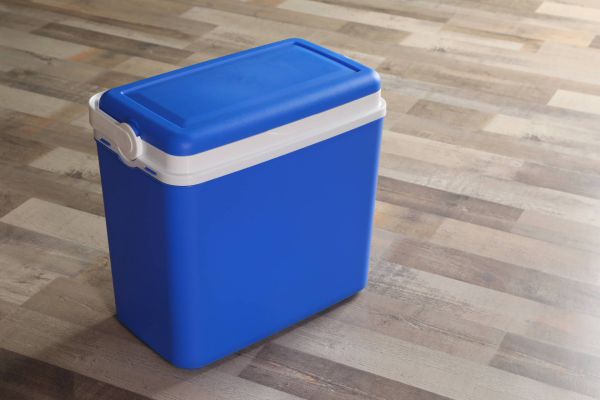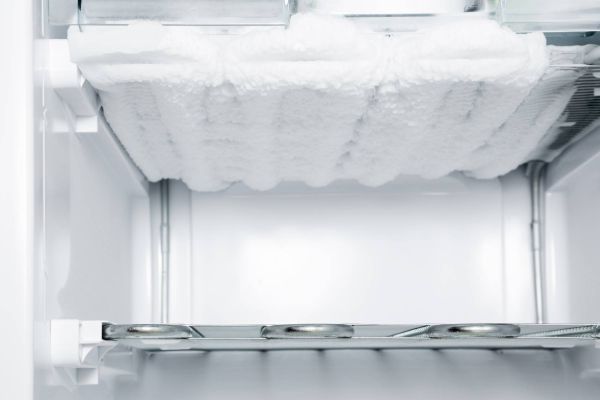Defrosting the refrigerator: How to do it right
A layer of ice in the refrigerator or freezer not only increases electricity costs, but also takes up a lot of space. With our instructions, you can defrost the refrigerator quickly and easily.
Why do you have to defrost the refrigerator?
Whether in the refrigerator with freezer compartment, in the fridge-freezer combination or in the freezer: In many appliances, ice forms on the walls or cooling fins (below the drawers in freezers) over time. It occurs because when the door is opened, warm (and therefore more humid) air comes in from the room, which then freezes. Food can also release warm air after being placed inside.
The ice forms exactly on the surfaces where the refrigerator or freezer extracts heat from the interior (the so-called "heat exchanger surfaces"). But ice acts like an insulating layer. The devices have to work longer to reach the preset temperature in the interior. This can increase electricity consumption by 10 to 15 percent. Even a layer of ice that is just two millimeters thick can result in increased energy consumption. At the latest when there is a layer of ice of one centimetre, you should defrost your refrigerator. The layer also reduces the already limited space in the freezer.
In addition, particularly thick layers of ice in freezers or freezers may no longer reach the -18 °C required for freezing – the food would then spoil more quickly.

Before defrosting, you must empty the refrigerator.
How often and for how long should you defrost a refrigerator?
The degree of icing is decisive for how long a refrigerator or the freezer compartment it takes to defrost. So if you defrost the device regularly, you can prevent severe ice formation. Consequently, the defrosting time is also shorter. The process can take several hours – so allow one to two hours for a freezer.
In principle, refrigerators, freezers and freezers can be defrosted according to the same principle. The only difference is that freezer units often have a thicker layer of ice. Therefore, de-icing may take a little longer.
And how often should you defrost the refrigerator? Ideally, you should do the whole thing once or twice a year. Or when the compartment puts on too much ice.
Why is the back wall of the refrigerator iced up?
If icing forms on the back wall of the refrigerator, it is often due to an incorrectly set temperature. If you set the thermostat too low, the compressor will run at too short intervals. The result is cooling of the rear wall. Since the cooler air absorbs even less moisture, it settles on the back wall and freezes.
You can easily solve the problem and save additional energy if you set the thermostat to 6 to 7°C.
Defrosting the refrigerator: Where to put the food?
Before you can defrost the refrigerator, you need to empty it. This requires a bit of planning because the food has to be stored temporarily. Therefore, it is best to consume as much food as possible, so you only have to find a storage solution for the rest.
For example, pay attention to medications that should be stored refrigerated throughout. Your neighbours may help you out with temporary storage - or you may use an electric cooler as an alternative

Perishable food can be temporarily stored in a cool box.
How to defrost the refrigerator? Instructions in nine steps
1. Plan to defrost the refrigerator
A defrosted refrigerator or ice-free freezer compartments offer the best way to clean thoroughly again. Therefore, it is best to gather the necessary cleaning utensils now. For defrosting and cleaning, you will need the following things:
- Shallow bowl or deep baking sheet
- Absorbent towels
- Spatula made of wood or plastic, wooden spoon if necessary
- Buckets, rags, cleaning agents
- Cool box / cooler bag
- Gloves
2. Turn off the refrigerator to defrost
First, turn off the refrigerator (with freezer compartment or freezer) or freezer. It is best to unplug it from the socket. In the case of fridge-freezer combinations, the following applies: If the freezer compartment cannot be switched off separately, disconnect the entire appliance from the mains.
3. Clear out food and store it in a cool place
The best way to do this is in a cool box or a cooler bag in which you pack ice packs. A cold cellar is also suitable for the short-term storage of sausage, cheese and other dairy products. If the temperatures are colder outside, you can temporarily store some food on the balcony, terrace or in the garden. Make sure they are well packaged.
Almost all domestic fruit and vegetables can be stored outside up to an outside temperature of 10 °C. Only tomatoes, potatoes or pumpkins don't like it so fresh. Dairy products can withstand up to 7 °C.
It is better to consume perishable foods such as fresh meat or leftovers - or ask your neighbours if you can put them in the fridge for a short time.
Frosty days are ideal for defrosting a freezer or freezer. Then you can store the food in the winter cold in the meantime. But they can also survive a few hours in the cooler. If you wrap the food thickly with a blanket or newspapers, you can also delay the thawing a little.
4. Clear out accessories
Remove all compartments, shelves and drawers from the refrigerator and set them aside. You can clean them right away by washing them off.
5. Place the baking tray or towels in front of the freezer
In the case of heavily frozen freezers or fridge-freezer combinations, the thawed water can leak out simply because of the large quantity. Therefore, place absorbent towels (terry cloth!) in front of it or slide a baking tray halfway under your refrigerator. Some have a kind of spout nozzle attached, which makes it easier to thaw. To be on the safe side, you can also lay out towels on the floor in the refrigerator itself.
6. Defrost the refrigerator
In general, defrosting does not work quickly, but takes several hours at room temperature. For freezers and chests, you should plan for the whole night.
When defrosting your refrigerator, you may ask yourself: open the door or close? The answer is: It depends on how much patience you have.
Open the door: If you leave the door of the refrigerator or freezer open, it will take a little longer to defrost. On the other hand, the process is also gentler on the sensitive parts of the appliance because the ice thaws slowly.
Door closed: To ensure that the ice in the refrigerator thaws quickly, you have to help a little. Place a small pot of hot water in the fridge, preferably on top of a few towels. Then close the door so that the heat stays inside. The hot steam causes the ice to melt faster than the normal ambient air.
7. Carefully scrape off the thawed ice
In the case of thick lumps of ice in the freezer or freezer, it makes sense to remove them from the walls while they have thawed. However, only use blunt objects to scrape off, such as a wooden or plastic spatula or a wooden spoon. Do not use a knife under any circumstances, as this will only damage the surface of the refrigerator or a cooling fin of the freezer!
8. Clean the refrigerator after defrosting
When all the ice is gone, wipe the refrigerator thoroughly with a sponge and dish soap on all sides. If your refrigerator has developed unpleasant odors, you can go over it with vinegar diluted with water . Then wipe all surfaces dry with a cloth. Floors and other accessories should be washed once during defrosting. Now put them back in the refrigerator.
9. Turn the refrigerator back on after defrosting
Finally, check again that everything is really dry. This is because moisture would immediately lead to new ice formation.
Finally, you can turn the fridge back on and put the food inside.
Good to know: Have you movedand your refrigerator hasbeen transported? Then wait before switching it on: two hoursafter a continuous transport and 24 hours after a continuous transport. During this time, the coolant that ran out of the compressor into the cooling circuit during transport can flow back into the cooling circuit. If this is not sufficiently present in the compressor, the device can be damaged.

In freezers, it is mainly the cooling fins below the drawers that freeze up.
Your refrigerator won't start after defrosting?
If your refrigerator no longer works properly, there can be many causes. In most cases, however, the thermostat is simply defective. Even if you have it set correctly, the refrigerator does not turn on in this case even when cooling is needed.
A thermostat uses sensors to determine the internal temperature of the refrigerator. If there is a need for cooling, the engine of the refrigeration unit switches on until the desired temperature is reached. Good to know: In the refrigerator, settings of levels 1 to 3, i.e. 3 to 7°C, are ideal.
If your refrigerator no longer starts or no longer cools properly, the first thing to do is to check whether the thermostat is not set correctly. If this is not the solution, have a specialist check whether the thermostat is defective. If a replacement is necessary, the spare part usually costs between 20 and 50 euros.
Can you defrost a freezer compartment without turning off the refrigerator?
Defrosting and de-icing the refrigerator without turning it off doesn't really work well. The device's thermostat would simply increase the cooling capacity. The compressor would then try to regulate and reduce the artificially increased temperature again, resulting in wasted energy. There is also a risk of overheating of the device.
Some still try to defrost without turning off the refrigerator. To do this, for example, they put boiling water in a pot on a mat in the freezer for 20 to 30 minutes and close the door. However, if there is too little hot water in the freezer, this leads to a strengthening of the ice layer rather than defrosting it. All in all, this approach is not a good idea!
If you are very impatient, it is sometimes recommended to speed up the defrosting process with a fan or a hair dryer. However, due to the high power consumption, we also advise against this method.
Defrosting the refrigerator: tips and tricks
Less ice is better
Defrosting consumes a lot of energy. This is because the refrigerator or freezer heats up, as do chilled food and frozen food. Everything has to be cooled down again after defrosting. A good energy-saving tip is to specifically prevent ice formation:
- Do not open the fridge/freezer too often and for too long
- Freezing food in airtight and waterproof packaging
- Do not put hot food in the fridge/freezer
- Check whether the seal of the refrigerator still closes tightly
Automatic defrost or no-frost function?
With appliances with a no-frost function, you no longer need to defrost the freezer compartment manually. Here, the indoor air circulates so that the humidity is continuously dissipated. This prevents icing.
In the meantime, there are also freezers in which the freezer units are automatically defrosted. This is quite practical, but also requires additional energy. Such automatic defrost systems consume about ten to 15 percent more electricity than a comparable device from the same energy efficiency class.
Defrosting the refrigerator before moving house and vacation
Before moving, the refrigerator should already be defrosted. Otherwise, the condensation water will leak out during transport and damage your belongings in the boxes. This means that you should start de-icing the freezer compartment or freezer at least two days before the move. For the meantime and the day of the move, a cool box is usually sufficient.
If you are going on holiday for several weeks, it can sometimes make sense to switch off the fridge completely and thus save electricity. However, it must be empty to do so – and you may have to defrost the freezer compartment of your refrigerator beforehand. During the holiday, the door should then be open to avoid mould or odour formation.
Join the conversation